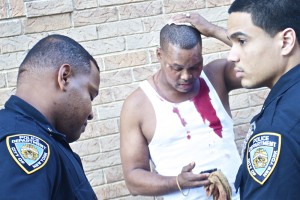Weekend mornings in Melrose are usually about sounds that help people relax. There’s the bell from the Church of Immaculate Conception, and soft music from shops that have just opened up for business. So when Maximino Rivera heard shots early on a Saturday last November, he couldn’t believe his ears. Minutes later, he walked in on an armored truck that had just been looted on Third Avenue.

Members of the South Bronx Community Congress, a consortium of various community organizations, demand more jobs to control violence. (NASR UL HADI/The Bronx Ink)
The weekend after, Rivera and other members of the South Bronx Community Congress — a consortium of various community organizations — marched down Brook Avenue in Mott Haven, demanding measures to control the violence. “We haven’t seen such heists since the 70s,” said Rivera, who has been involved with welfare work since 1989. “The statistics may or may not show it, but we can see that violence is becoming a bigger problem.”
Rivera’s instincts are fairly accurate. The South Bronx’s 40th Precinct, an area of less than three square miles, has reported almost 500 incidents of violent crime this year. More than 90 percent of these are felonious assaults, mostly shootings. In October, six incidents of gun violence were reported on a single Sunday.
Violence has climbed steadily, almost straight up, since 2008. This year’s toll — both overall, and individually for murder, rape and assault — is the highest in at least five years. The count so far is at least 20 murders and 23 rapes; that’s about one of each every two weeks, in a population of less than 180,000.
Statistics
Murders in the community have gone up by more than 35 percent since last year. The last time this number was at par with the average across other precincts in the Bronx was in 2008. Since then, the borough’s average has remained below 12, while the 40th’s numbers have gone up by more than 50 percent.
The 2006 Community Health Profiles rank homicide among the top five causes of premature death in Mott Haven.
The rise in incidents of sexual violence is even more disturbing. Rapes are up by 75 percent since last year. Also, for the first time in five years, the 40th has registered more incidents than the borough’s average per precinct.
Assaults in the neighborhood remain at a much higher threshold than the rest of the Bronx, and the gap has been widening consistently. There were 445 incidents of felonious assault in the 40th Precinct this year, 20 percent more than the borough average of 367.
Analysis
Banners at the residents’ march against violence primarily demanded more jobs and less poverty, as a solution to the spike in violence. “It’s all about connecting the dots between our social problems and violence,” said Raymond Figueroa, who runs a development program for incarcerated youth at Brook Park.
“Poverty and unemployment statistics are like canaries in the mine,” he said. “The minute they start acting up, you know that the situation is becoming dangerous. It’s a circle. Violence happens when people are violated.”
Figueroa explained that there are several jobs in the neighborhood that are just not available to locals, mostly because they are not educated enough. “Our schools haven’t been able to help our children, because they don’t have enough human resources to address our needs,” he said.
New York University’s Furman Center found that more than 75 percent of students in Mott Haven and Hunts Point perform below grade level in reading. In math, that number is almost 65 percent. Eventually these students drop out; more than half the residents in this community do not have a high school diploma.
“These unemployed youth then turn to underground businesses,” said Figueroa. “Prostitution and drug/gun running provide something that is very tangible and immediate.”
This reasoning does seem to hold ground. At least two-thirds of those involved in this year’s murders — both victims and perpetrators — were 25 or younger. Also, all the data charts shared earlier in this text show the 2008-09 recession to be the start of the upward trend in violent crime. During the same period, unemployment in this community doubled, going from about 9 percent to more than 18 percent.
“Joblessness feeds poverty in our community,” reiterated Figueroa, “which in turn makes it difficult for our kids to stick to school.” The 2006 Community Health Profiles estimate the poverty level in Mott Haven at 45 percent, twice as much as New York City overall.
“Poor school-age kids eventually turn to friends on the street for support, and that’s how they become gangs. The Dominicans go to the Trinitarios, the African Americans stick with the Bloods, the Puerto Ricans with the Latin Kings, and so on.”
“We call them gangs, but they think of themselves as street families,” he said. “And these families run the underground economy, which is the source of most violence.”
















